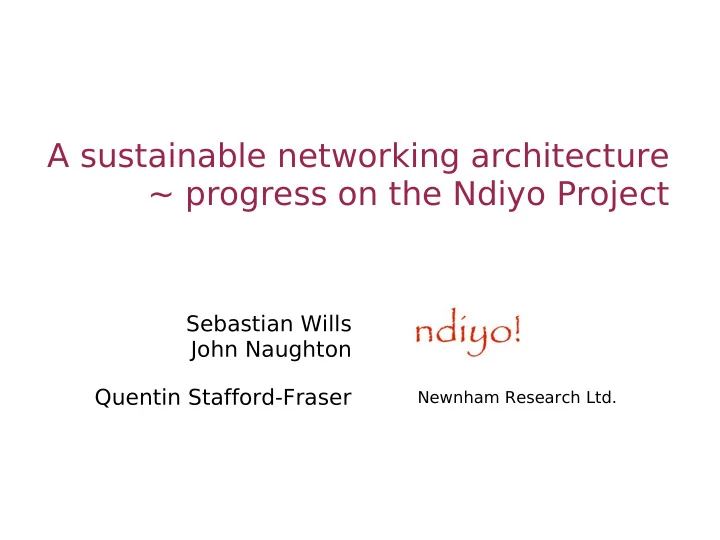

A sustainable networking architecture ~ progress on the Ndiyo Project Sebastian Wills John Naughton Quentin Stafford-Fraser Newnham Research Ltd.
The problem ● Expensive ($400+ hardware excluding screen; $300+ software) ● Unnecessarily replicated components – Frequent hardware failure – System administration hassles ● Inefficient utilisation over time ● Inflexible ● Environmentally damaging ● Needs replacing every 3 years! Not a sustainable way of providing networked computer workstations!
The Ndiyo vision ● Rethinking networked computing to make it – Affordable (for the next two billion people) – Sustainable ● Environmentally ● Adminstratively ● Economically – Open (non-proprietary) ● Stimulating development of requisite technology ● Evangelising
Ndiyo approach ● Not-for-profit ● Freedom to rethink – No commercial constraints ● Values – Digital divide as 21st-century poverty – Ensuring ICT escapes proprietary control – Sustainable, decentralised models of income generation (not charity)
Trimming the fat ● Hardware – Minimise replication: put all the complexity in one box – No need for separate CPUs, HDDs, RAM, PSUs, cases ● Software – OSS exists and works: use it! – Software installed centrally: reduce administration
Two-pronged strategy ● Thin-client networking with ultra-thin-client hardware ● Open Source software server
Hardware
Typical thin-client design strategy ● Take a PC, remove stuff ● Target large organisations with 100s or 1000s of seats ● Require software licenses per seat (Windows Terminal Server...)
Thin-client computing done right ● Start with monitor, see what you need to add ● All complexity at server. Send raw pixels, with simple compression. – Convert to VNC/RDP at server. ● 100Mbit ethernet is fast enough to get away with this!
● “Network In, Video Out” ( nivo ) ● Current demonstrator: – 12 x 8 x 2cm – Ethernet, power, keyboard, mouse & VGA ports – 2Mb video RAM, FPGA, Ethernet controller ● Next version to add: – sound, local USB ports ● Cost: Already sub £100
The vision for hardware ● Nivo becomes a chip inside monitor ● Monitors will have ethernet inputs in addition to VGA/DVI – Monitor with just an ethernet port requires less electronics than a standard VGA input
Ndiyo system
Target scenarios ● Internet Café ● School classroom ● Small business
Ndiyo system: hardware ● Cluster of workstations – One or more servers ● Plug and play clustering
Ndiyo system: software ● Linux OS (Ubuntu) with Nivo driver ● Gnome/KDE desktop ● OpenOffice, Firefox, GAIM, Thunderbird
System capacity ● Application-specific ● 'Office' use (word-processing etc.) – 20 clients, Gigabit switch, single server (2GHz, 2GB RAM ~ £800) ● Software development
5 Java developers building and testing large apps, extreme programming, single 2GHz, 2GB server. Running continuously since August 2004 Application: software development
Benefits ● Affordability ● Environmental impact ● Administration ● User experience ● Robustness
Affordability ● Lower up-front costs – 30/40% of comparable Windows-based network – 50% of proprietary thin-client network (e.g. Sun Ray) ● Lower upgrade costs – Nothing to upgrade at client end (pixels are pixels!) ● TCO
Environmental footprint ● Manufacture phase: – PC with 17” CRT: ● 260kg fossil fuels (≈50% due to CRT) – Nivo in current form ● 8kg fossil fuels – Nivo + CRT + tenth share of PC as server: ● 40% saving, without shrinking any further ● Use phase: – PC base: 100W; 17” CRT: 75W – Nivo: 5W
Administration ● Centrally-administered software ● Trivial to add more clients ● Better security
User experience ● A share of a fast server can feel faster than a cheap PC to yourself ● Physically more discreet and flexible
Robustness ● Clients extremely reliable ● Only the server needs a protected power supply ● Clustered servers: plug-and-play redundant storage and failover
Disadvantages ● Currently requires wired ethernet to a server ● No local drives (e.g. flash keys) in current version ● Limited multimedia
Summary ● “One user, one PC” is an unsustainable way to provide networked computing ● Ultra-thin client hardware is a reality, given today’s network bandwidth ● Ultra-thin client + Open Source software provides a robust, more affordable, and more sustainable solution
For more information, please contact info@ndiyo.org
Recommend
More recommend